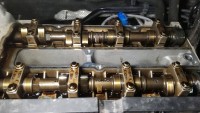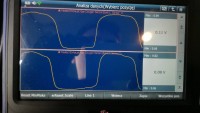Hello,
there was a similar topic here, but I set up a new one because that was resolved and there were some other malfunctions.
I am fighting the Focus of 2015 with the 1.6 duratec engine with 45 thousand km. After starting the car works properly for 1-2 minutes, after which it starts walking unevenly. In real terms, it can be seen that the ignition falls on the 2nd and 3rd cylinder, most likely because the engine controller depletes the mixture, reducing the injection time for the 2nd and 3rd injection. (Ignitions fall out like injection times look as follows: 1.cyl: about 5ms; 2.cyl: about 3ms; 3.cyl: about 3ms; 4.cyl: about 5ms. During the ride, most of the time is good, it has power, it doesn't tug, sometimes he can only silence for a moment (then ignites for 2 and 3 cyl) but does not feel the characteristic ignition falling out, as when piercing a spark.
What I did / checked:
- I changed the candles to iridium DENSO according to the catalog - they were mounted nickel-plated
- compression after 14atm
- injections swapped, coil replaced, wires not pierced
- disconnecting the flow meter and probes does not change anything - ignition continues to fall on 2 and 3 cyl
- unscrewing the probe in front of the catalyst also gives nothing, i.e.
- disconnecting the variable valve timing adjusters also changes nothing
- air-tight intake
- fuel pressure OK
- damper cleaned, potentiometers approx
- the beam is also OK
Before eliminating the above components, I reset the G-SCAN2 adaptation values every time
I can't understand why the engine control unit reduces the injection time to 2 and 3, since the consequence is a loss of ignition.
I'm counting on brainstorming
there was a similar topic here, but I set up a new one because that was resolved and there were some other malfunctions.
I am fighting the Focus of 2015 with the 1.6 duratec engine with 45 thousand km. After starting the car works properly for 1-2 minutes, after which it starts walking unevenly. In real terms, it can be seen that the ignition falls on the 2nd and 3rd cylinder, most likely because the engine controller depletes the mixture, reducing the injection time for the 2nd and 3rd injection. (Ignitions fall out like injection times look as follows: 1.cyl: about 5ms; 2.cyl: about 3ms; 3.cyl: about 3ms; 4.cyl: about 5ms. During the ride, most of the time is good, it has power, it doesn't tug, sometimes he can only silence for a moment (then ignites for 2 and 3 cyl) but does not feel the characteristic ignition falling out, as when piercing a spark.
What I did / checked:
- I changed the candles to iridium DENSO according to the catalog - they were mounted nickel-plated
- compression after 14atm
- injections swapped, coil replaced, wires not pierced
- disconnecting the flow meter and probes does not change anything - ignition continues to fall on 2 and 3 cyl
- unscrewing the probe in front of the catalyst also gives nothing, i.e.
- disconnecting the variable valve timing adjusters also changes nothing
- air-tight intake
- fuel pressure OK
- damper cleaned, potentiometers approx
- the beam is also OK
Before eliminating the above components, I reset the G-SCAN2 adaptation values every time
I can't understand why the engine control unit reduces the injection time to 2 and 3, since the consequence is a loss of ignition.
I'm counting on brainstorming





